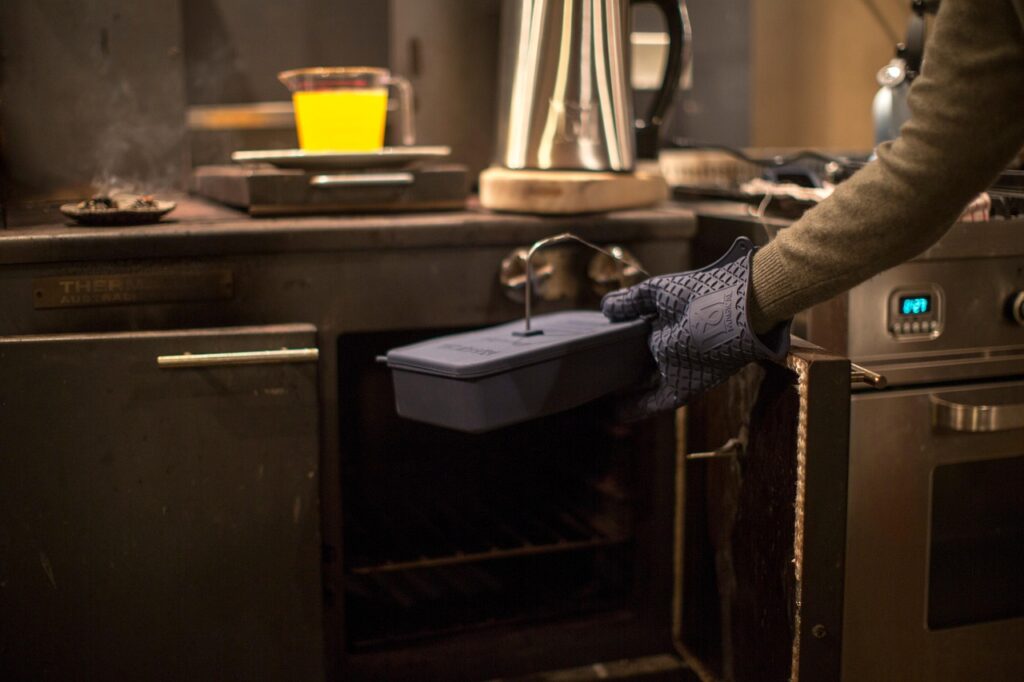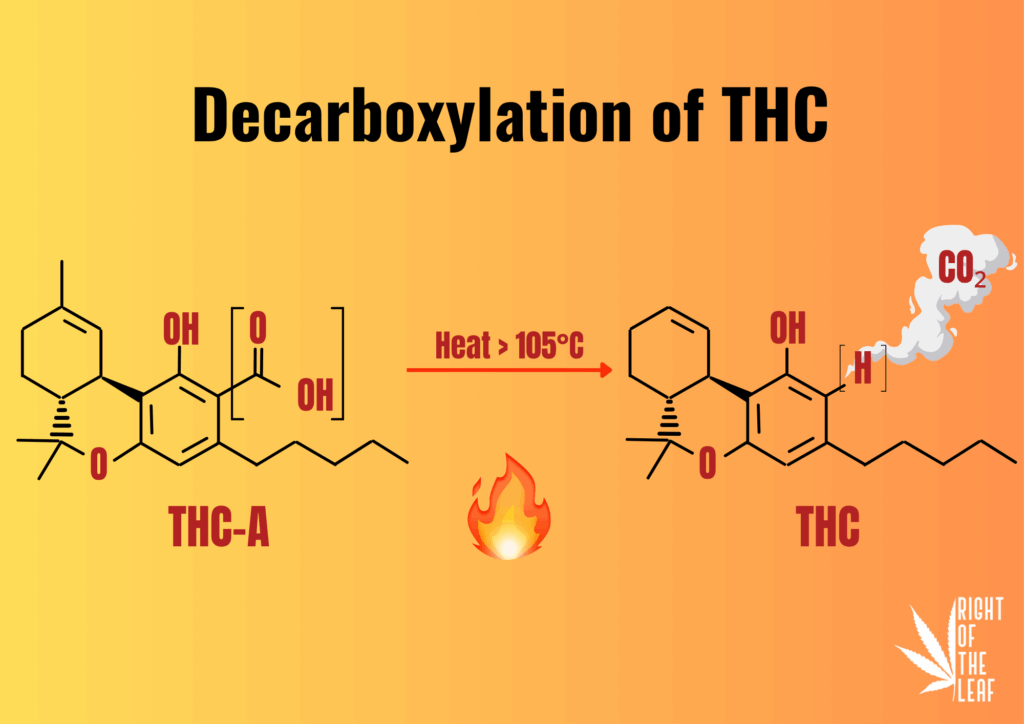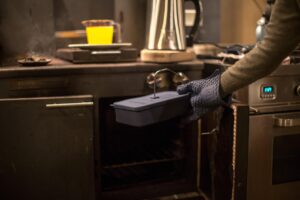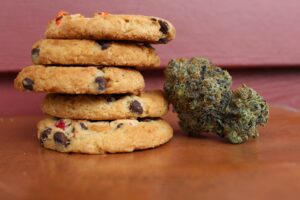Decarboxylation 101: Unlocking THC and CBD

While you could eat the raw cannabis flower straight from the bag or plant, you wouldn’t experience any of the psychoactive or other beneficial effects. Decarboxylation is a chemical reaction that activates all psychoactive and beneficial cannabinoid compounds for use in potent edibles, tinctures, or topicals. Understanding the steps and science behind this process will help you optimize the experience for you and the friends you are sharing with.
What is Decarboxylation?
Decarboxylation is the chemical reaction that removes a carboxyl group (COOH) from the cannabinoid acids in raw cannabis, activating them for oral and topical application. Simply put, this is the process that activates the psychoactive and therapeutic compounds in your cannabis flower.

Raw cannabis contains the acidic forms of the cannabinoids THC-A (tetrahydrocannabinolic acid) and CBD-A (cannabidiolic acid), which are the most popular of the current cannabinoids on the market. Via decarboxylation, these acidic compounds are activated by the removal of the carboxyl group (COOH), transforming THC-A into THC (tetrahydrocannabinol) and CBD-A into CBD (cannabidiol). By applying heat and time, you can remove this carboxyl group and activate those desired compounds. Heat is the common factor across all consumption methods.
Why Do You Need to Decarboxylate Cannabis?
To fully activate your cannabis for use, you must decarboxylate it first, and here’s why:
- Unlocks Psychoactive Properties: The psychoactive properties only become available after the THC has been transitioned from THC-A via decarboxylation. This allows you to experience a euphoric and cerebral high.
- Enhances Bioavailability: The process of decarboxylation allows a greater portion of the cannabinoids to be absorbed into the body through edibles, tinctures, and oils.
- Optimizes Medical Benefits: The transition from THC-A and CBD-A to THC and CBD enables better interactions within your body’s endocannabinoid system, making it more efficient and maximizing therapeutic effects.
Skipping this crucial step in your edible-making journey will result in a weaker or effective product when compared to adequately decarboxylated cannabis.
How Does Decarboxylation Work?
Decarboxylation naturally occurs over time and with exposure to oxygen. However, when making edibles, tinctures, and topicals, efficiency becomes a key consideration, and heat becomes your best friend. With each of the consumption methods, introducing heat is crucial to thoroughly enjoying the product’s effects.

- Smoking/Vaporizing/Dabbing: Through each of these three methods of consumption, heat is introduced to the cannabis either by direct flame, a preheated device or an electronic vaporizer. This heat immediately transitions the cannabinoids from their acidic form to the more psychoactive and beneficial decarboxylated form.
- Curing & Drying: While drying and curing your cannabis, small amounts of the cannabinoids will begin to decarboxylate and mature. The amounts of cannabinoids that decarboxylate at this time are minimal.
- Controlled Heat Application: When making edibles, tinctures, or infusions, decarboxylation must occur over a specific time. This is best achieved with an oven or a specific cannabis decarboxylation device, such as the Magic Butter Machine.
Since oxygen exposure is a cause of decarboxylation, home growers know that once their bud is cured, long-term storage is best in an airtight container to help maintain freshness and potency.
How to Decarboxylate Your Weed
When decarboxylating weed for edibles, topicals, and tinctures, the goal is to activate all the compounds without destroying the plant or degrading the cannabinoids. Utilizing a lower heat level over time allows you to maintain the cannabinoid and terpene profile of the cannabis flower you are working with. Temperatures over 300°F will destroy the desired compounds you are aiming to decarboxylate.
The best way to accomplish this:

- Set the Oven to 225°F
- Loosely Grind Cannabis Flower
- Spread the flower evenly over a baking sheet with parchment paper or tinfoil.
- Heat for 30-45 min to activate cannabinoids.
Once this decarboxylation is complete, the flower can be used for edibles, tinctures, oils, or consumed directly. It is ready for any medical need or use.
How to Use Decarboxylated Weed
After completing the decarboxylation process with your cannabis, you can use it in a variety of ways:
- Infused into Butter or Oil: Cannabinoids and the other elements you activate through decarboxylation are best carried by fatty substances like butter, shortening, lard or oils. This is the foundation of the traditional edible and most homemade goodies. It can be easily added to any recipe that contains a fatty or oily ingredient.
- Make Tinctures: Potent tinctures can be created by soaking the decarboxylated cannabis in high-proof alcohol. These tinctures can be added to drinks or meals or sublingually for the desired effects.
- Create Topicals: Coconut oils and creams can be infused with decarboxylated cannabis to provide you with a smoke-free, easy-to-use product for localized relief of physical pains and symptoms.
- Capsules: Filling capsules with pre-weighted decarboxylated cannabis gives you a convenient and discrete smoke-free method of consumption that is easily enjoyed at home and on the go.
 While experimenting with decarboxylated cannabis, the crucial aspect to remember is to start low and go slow. The significant delay alongside oral-based consumption can be misleading and lead to overconsumption. Allowing up to two hours for the full effects to build up will be the best option to support a more enjoyable and manageable high.
While experimenting with decarboxylated cannabis, the crucial aspect to remember is to start low and go slow. The significant delay alongside oral-based consumption can be misleading and lead to overconsumption. Allowing up to two hours for the full effects to build up will be the best option to support a more enjoyable and manageable high.
Final Thoughts
While the actual art of baking can be challenging in its own way, preparing your cannabis for those projects doesn’t have to be. Learning how to properly decarboxylate your cannabis before infusing it into your brownies, cookies, or other baking essentials. Taking the time to prepare and decarboxylate your cannabis correctly will help you ensure you get the most out of your harvests and efforts in the kitchen.
